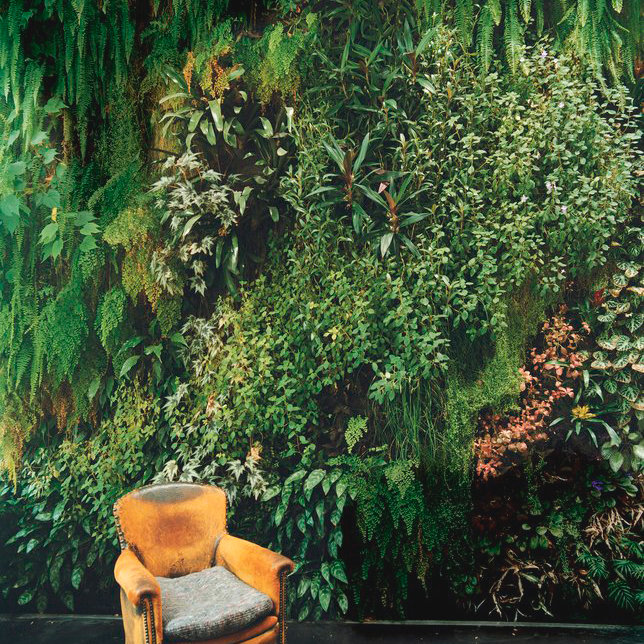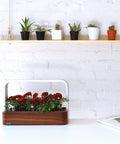
Wall gardens, also known as vertical gardens, green walls, plant walls, or living walls, is an increasingly popular trend in today’s architecture. A wallgarden is vegetation that grows vertically or on a wall, typically equipped with a special growing soil and a custom watering system. Wall gardens are also a variation of outdoor green facades, developed earlier much earlier in time, in where soil is placed at the bottom of the wall and vines and other climbing plants grow tall upward.
We can all appreciate the aesthetic and calming features when in the presence of wall gardens, but it does make us wonder - where did these green walls come from and why?
The Roots of The WallGarden:
Ancient
Wall gardens and green facades are believed to date back to antiquity. The legendary Hanging Gardens of Babylon, one of the Seven Wonders of the Ancient World, were fabled to be constructed on the orders of King Nebuchadnezzar II (reigned 605-562 BCE) for his foreign wife Queen Amytis, because she missed the green hills and valleys of her homeland. A variety of trees, shrubs, and vines were placed on mud bricks to resemble green mountains. The gardens were even planted on tiered terraces and irrigated through a system of waterwheels, pumps, and cisterns that drew water from the Euphrates River.
1930s

Modern-looking wall gardens originated in the 20th century. In 1938, Stanley Hart White, a professor of landscape architecture at the University of Illinois, patented the first known system for creating a vertical garden. His patent, titled: “Vegetation-Bearing Architectonic Structure and System”, described it as a method "for producing an architectonic structure of any buildable size, shape or height, whose visible or exposed surfaces may present a permanently growing covering of vegetation." He further described the art and technology aspects of his invention in his patent, where he defined a new garden typology not fully realized until after his death.
1980s

In 1986, the Cité des Sciences et de l'Industrie in Paris exhibited the first successful large indoor wall garden. It had been developed by botanist Patrick Blanc, engineer Peter Rice, and architect Adrian Fainsilber. Blanc’s work made wall gardens more popular and more technically feasible.
2000s

Nearly 20 years later, botanist Patrick Blanc collaborated once again with another architect, Jean Nouvel, to create an outdoor wall garden for the Musée du Quai Branly – Jacques Chirac’s administrative building. From here it was determined that wall gardens incorporated botany, engineering, and architecture in a beautiful way that could be scaled in the future.
Future

The ēdn WallGarden is the world’s first automated indoor wall garden. Invented in 2016 by engineer and horticulturist, Ryan Woltz, the ēdn WallGarden displays rows of sustainably-sourced wood that contains up to 16 plants at a time using NASA-inspired “SeedPods”. These soil-free pods are plant inserts that take the hassle out of sowing seeds in a garden, so all you have to do it pop them in and add water. The garden is completely automatic, equipped with a small computer that automates the lights and watering of the garden, making it practically maintenance-free. The indoor WallGarden, while still in development, is a modern-day green wall that uses futuristic technology to enhance the growing of plants, all whilst displaying a living art piece. There has been much attraction around the WallGarden since ēdn debuted on Shark Tank in 2018, with contractors and individuals alike reaching out to source the product as a built-in for homes, apartments complexes, and even office spaces. The WallGarden is a larger version of ēdn’s currently released SmallGarden, which is a more compact and affordable table-top version of the product. The WallGarden aims to perfect the revolutionizing technology that it will bring to the future of biophilic design and living green walls.
Click here to learn more about joining the WallGarden waitlist.
Benefits of WallGardens:
Wall gardens greatly range in size, biodiversity, design, functionality, and environment. There are a variety of advantages to wall gardens, from eco-friendly improvements to health benefits:
Improves Health
Vertical gardens benefit people’s psychological health. According to the scientific concept of Biophilia, human beings are hardwired to crave natural surroundings. Indoor plants have been scientifically shown to reduce stress and even lower blood pressure in humans. This translates into greater productivity and less absenteeism when a wallgarden is present in a business setting. Indoor green walls provide such health benefits all year long, which is particularly important in regions with cold winters such as busy cities like Boston and New York City. Learn more about the benefits of bringing plants inside > Here.
Reduces Noise
Wall gardens also muffle noise and help reduce sound levels in loud settings. Indoor plants in general, improve acoustics, as the added surface area provided by their leaves and flowers enables them to absorb sound.
Improves Air Quality
Indoor plants can improve indoor air quality (IAQ) by reducing carbon dioxide, volatile organic compounds (VOCs), and other toxins in the air. A botanist named Alan Darlington has even developed the concept of "biofiltration" which uses plants in an HVAC system. The roots of plants also contain helpful microorganisms that can break down harmful VOCs and purify the air.
Eco-Friendly Insulating
Wall gardens on a building’s exterior can even help reduce temperature fluctuations within it. The plants insulate the building from the sun’s UV rays by reflecting them rather than absorbing them. Additional cooling is also provided when moisture in the plant cells is evaporated. A wall garden thus increases a building’s sustainability by reducing the amount of energy needed to cool it, all while saving money on energy costs needed for air conditioning.
Saved Plant Space
Wall gardens save space. If a small office or home doesn’t have floor space for lots of plants, they can be mounted on a wall to increase visibility for all to enjoy.
Where Can You Find Wall Gardens?
Indoor wall gardens are all around you. Because humans have an innate longing for nature, we are attracted to plants even though we may not fully realize it. Places like hotels, apartments, retail stores, cafes, and offices incorporate living plants to reconnect people with nature on a daily basis.










